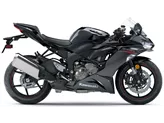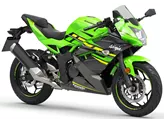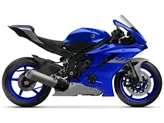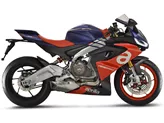Yamaha YZF-R6 2019 vs. Kawasaki Ninja ZX-6R 2019

Yamaha YZF-R6 2019

Kawasaki Ninja ZX-6R 2019
Overview - Yamaha YZF-R6 2019 vs Kawasaki Ninja ZX-6R 2019
The Yamaha YZF-R6 2019 and the Kawasaki Ninja ZX-6R 2019 are both supersport motorcycles that offer exhilarating performance and advanced features.
Starting with the engine and drivetrain, both bikes have an inline four-cylinder engine with a bore of 67mm. However, the Yamaha has a stroke of 42.5mm while the Kawasaki has a stroke of 45.1mm. This results in the Kawasaki producing slightly more power at 130 HP compared to the Yamaha's 118 HP. The torque output is also higher on the Kawasaki at 70.8 Nm compared to the Yamaha's 65.7 Nm. Both bikes have a compression ratio of around 13, with the Yamaha being slightly higher at 13.1.
In terms of suspension, both bikes feature upside-down telescopic forks at the front and a swing arm with a monoshock at the rear. The Yamaha has a larger front fork diameter of 43mm compared to the Kawasaki's 41mm. Both bikes offer adjustable compression, preload, and rebound settings for the suspension. The rear suspension material is aluminum on both bikes.

Yamaha YZF-R6 2019
In terms of chassis, both bikes have an aluminum frame. The Yamaha has a Deltabox frame type, while the Kawasaki has a Twin Tube, Perimeter, Extruded frame type. Both bikes have a similar rake angle of around 66 degrees, but the Kawasaki has a slightly longer trail at 101mm compared to the Yamaha's 97mm.
For braking, both bikes have double disk brakes at the front with radial technology. The Yamaha has larger front disk diameters of 320mm compared to the Kawasaki's 310mm.
Both bikes come equipped with advanced rider assistance systems such as ABS, riding modes, ride by wire, and traction control.
In terms of dimensions and weights, both bikes have a front tire width of 120mm and a rear tire width of 180mm. The front and rear tire diameters are both 17 inches. The wheelbase is slightly longer on the Kawasaki at 1400mm compared to the Yamaha's 1375mm. The seat height is also lower on the Kawasaki at 830mm compared to the Yamaha's 850mm. Both bikes have a fuel tank capacity of 17 liters.

Kawasaki Ninja ZX-6R 2019
Moving on to the strengths and weaknesses of each bike, the Yamaha YZF-R6 2019 is praised for its top chassis, powerful brakes from the YZF-R1, sharp design, modern lighting system, mature electronics package, easy to read display interface, and rev-happy engine. However, some weaknesses include the engine lacking punch in the mid-range and a higher price compared to the Kawasaki.
On the other hand, the Kawasaki Ninja ZX-6R 2019 is praised for its great engine with a good mix of revving and torque, lively handling, responsive fork, and adjustable chassis. Some weaknesses include certain details lacking finesse such as the number plate holder and indicators, and the overall silhouette not being sporty enough.
In conclusion, both the Yamaha YZF-R6 2019 and the Kawasaki Ninja ZX-6R 2019 offer impressive performance and advanced features. The Yamaha excels in terms of chassis and braking, while the Kawasaki offers a great engine and responsive handling. Ultimately, the choice between the two will depend on individual preferences and priorities.
Technical Specifications Yamaha YZF-R6 2019 compared to Kawasaki Ninja ZX-6R 2019
Pros and Cons in comparison
Pros and Cons in comparison
Yamaha YZF-R6 2019

It almost seems as if the Yamaha YZF-R6 was born on the race track. It is easy to see that the R6 is the little sister of the YZF-R1. Whether it's the design, the ergonomics, the braking or the electronic aids - the racing genes are everywhere! The R6 is an outstanding piece of engineering in the 600cc class and, depending on your preferences, is probably the best 600cc bike currently available - at least for the racetrack. The Yamaha gives the rider unbelievably high precision and feedback over the front wheel and the chassis, and is super manageable at the same time! The engine is extremely rev-happy, but also wants to be kept happy. It is a pity that the latest version of the R6 has lost some of its power due to Euro 4... Nevertheless, it will be the faster track bike for most of us. And if there is a need, an open exhaust system (without road homologation) and mapping can tickle a few more horsepower out of the super sports bike. Sharp design meets even sharper components - TOP!
Kawasaki Ninja ZX-6R 2019

The Kawasaki Ninja ZX-6R is a perfectly sized supersport motorbike. With its 130 hp, sporty but controlled riding is possible. The shorter gearing and the 36cc extra displacement ensure that you can be a bit lazier on the road. A worthy flag-waver for the 600cc supersport segment.
Price Comparison Avarage Market Price Yamaha YZF-R6 vs Kawasaki Ninja ZX-6R
There are a few key differences between a Yamaha YZF-R6 2019 and a Kawasaki Ninja ZX-6R 2019. It takes less time to sell a Yamaha YZF-R6 with 140 days compared to 160 days for a Kawasaki Ninja ZX-6R. Since model year 2005 1000PS.de editors have written 33 reviews for the Yamaha YZF-R6 and 37 reviews for the Kawasaki Ninja ZX-6R since model year 2005. The first review for the Yamaha YZF-R6 was published on 10/17/2002 and now has more than 3,600 views. This compares to more than 5,800 views for the first review on Kawasaki Ninja ZX-6R published on 9/2/2002.
















